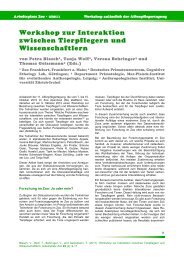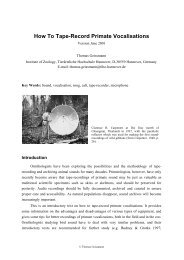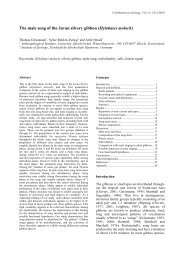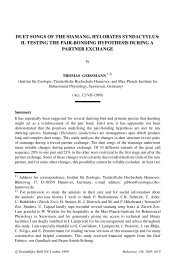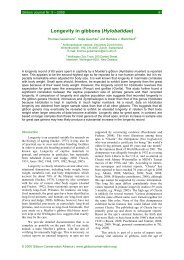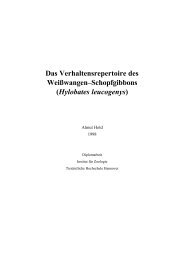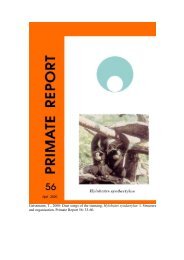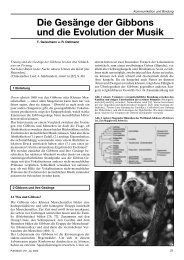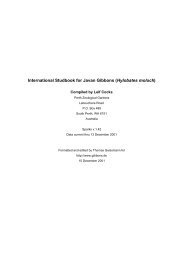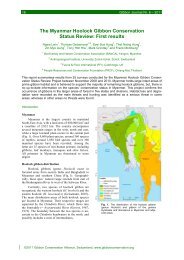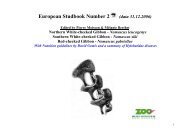captive management and conservation of gibbons in china and ...
captive management and conservation of gibbons in china and ...
captive management and conservation of gibbons in china and ...
You also want an ePaper? Increase the reach of your titles
YUMPU automatically turns print PDFs into web optimized ePapers that Google loves.
T. Geissmann: Gibbons <strong>in</strong> Ch<strong>in</strong>a <strong>and</strong> Vietnamspecies <strong>of</strong> the lar group, H. pileatus, occurs on Phu Quoc isl<strong>and</strong> (i.e. Vietnamese territory) (BÔKHOA HOC, 1992; van PEENEN et al., 1969), but there is, as yet, no reliable evidence for thisclaim. This idea apparently orig<strong>in</strong>ated from BOURRET (1946?), who suggested that the typelocality <strong>of</strong> H. pileatus ("a small isl<strong>and</strong> near Camboja", GRAY, 1861, p. 135) probably referredto Phu Quoc. Later, SIMONETTA (1957, p. 64) simply changed the type locality to Phu Quoc,without reveal<strong>in</strong>g his source <strong>of</strong> evidence. All <strong>gibbons</strong> <strong>of</strong> the lar group seen dur<strong>in</strong>g this studyare, therefore, likely to have been have imported (1 H. lar via Japan, 1 H. agilis albibarbis fromsouthwest Kalimantan, <strong>and</strong> 1 H. pileatus possibly from Cambodia or Laos).Age distribution:The <strong>captive</strong> gibbon population <strong>of</strong>Ch<strong>in</strong>a <strong>and</strong> Vietnam <strong>in</strong>cludes a relativelyhigh percentage <strong>of</strong> juvenile animals (36%). This is as high as the percentage <strong>of</strong>adult animals, as shown <strong>in</strong> Figure 6. Forcomparison, the values <strong>of</strong> the <strong>captive</strong>population <strong>of</strong> crested <strong>gibbons</strong> covered bythe first edition <strong>of</strong> the InternationalStudbook (LERNOULD, 1993, p. 93) arealso shown. The studbook sample <strong>in</strong>cludesonly 11% juveniles, but 64%adults. Almost all <strong>of</strong> these animals arekept <strong>in</strong> western countries <strong>and</strong> there is nooverlap with the gibbon sample exam<strong>in</strong>eddur<strong>in</strong>g this study.The difference <strong>in</strong> the age class distribution<strong>of</strong> the two samples can betentatively <strong>in</strong>terpreted as follows: In thestudbook sample, there is a large proportion<strong>of</strong> adults. Many <strong>of</strong> these animalswere apparently not breed<strong>in</strong>g at the time<strong>of</strong> the census, but the population appearsto have a high survival rate. In contrast,reproduction is virtually absent <strong>in</strong> the<strong>captive</strong> gibbon population <strong>of</strong> Ch<strong>in</strong>a <strong>and</strong>Vietnam. An apparently constant <strong>in</strong>flux<strong>of</strong> new, wild-caught animals makes up thehigh proportion <strong>of</strong> juvenile animals <strong>in</strong> thissample, but the survival rate <strong>of</strong> thejuveniles is apparently lower than <strong>in</strong> thestudbook sample.% <strong>of</strong> <strong>captive</strong> population806040200<strong>in</strong>f. juv. subad. ad.Age classCaptive <strong>gibbons</strong> <strong>in</strong> Ch<strong>in</strong>a <strong>and</strong> Vietnam"International Studbook Hylobates concolor"Fig. 6: Frequency (<strong>in</strong> %) <strong>of</strong> the four age classesamong a) <strong>captive</strong> <strong>gibbons</strong> <strong>in</strong> Ch<strong>in</strong>a <strong>and</strong> Vietnam(this study, n = 64), b) <strong>captive</strong> <strong>gibbons</strong> <strong>of</strong> theconcolor group accord<strong>in</strong>g to the "InternationalStudbook Hylobates concolor" (LERNOULD,1991, n = 181).Recommendations:The <strong>captive</strong> gibbon population <strong>in</strong> Ch<strong>in</strong>a <strong>and</strong> Vietnam could be <strong>of</strong> considerable importancefor <strong>conservation</strong> <strong>of</strong> these species, <strong>in</strong> view <strong>of</strong> their critical status <strong>in</strong> the wild. In the long run, themost reliable action plan should probably consist <strong>in</strong> build<strong>in</strong>g up self-susta<strong>in</strong><strong>in</strong>g <strong>captive</strong> gibbonpopulations with the ultimate goal <strong>of</strong> re<strong>in</strong>troduc<strong>in</strong>g <strong>captive</strong>-bred surplus animals <strong>in</strong>to suitablehabitats where a species has become ext<strong>in</strong>ct or too decimated to survive.Primate Report 42, April 1995 35



